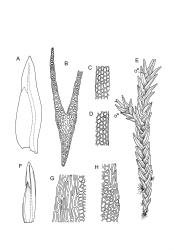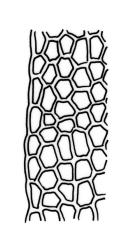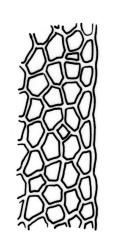Plants 5–30 mm, tufted. Leaves in 10–50 pairs, slightly overlapping at mid stem, erect-spreading, plane to decurved when moist, little altered and often with apices hidden in dorsal view when dry, broadly lanceolate, 1.5–3.0 × 0.3–0.8 mm; apex usually eroded in all but the youngest leaves; laminae partially and variably pluristratose; dorsal lamina ending at leaf insertion or shortly decurrent, tapered to its base; margins entire to very weakly crenulate; marginal cells of all laminae undifferentiated; cells of apical and dorsal laminae (7.5–)9–15(–22) × (6–)9–13(–17) µm. Costa often weakly sigmoid and sometimes overlaid by patches of lamina cells.
Dioicous? Perichaetia unknown. Perigonia terminal on main or axillary shoots. Sporophytes unknown.
Beever & Stone 1999, fig. 2, a–g, i–m, o, q; Beever et al. 2002, p. 56, figs 1–6.
Rheophytic mosses are known for their high phenotypic plasticity, which makes circumscription difficult (Carter et al. 2014). The original description of F. rigidulus var. pseudostrictus (Beever & Stone 1999) circumscribed a wider concept of the taxon than is accepted here. Partially bordered forms (e.g., P.J. Brownsey s.n., WELT M007840, cited as a paratype of F. rigidulus var. pseudostrictus) are here recognised, somewhat tentatively, as F. rigidulus var. rigidulus.
F. rigidulus var. pseudostrictus is characterised by unbordered, broadly lanceolate leaves, and a weakly sigmoid costa, which is sometimes overlaid by patches of encroaching lamina cells rendering the costa indistinct. On all but the youngest leaves the apex is usually eroded and the laminae heavily encrusted with black periphyton.
Shoots of the two varieties of F. rigidulus are generally distinct in their physiognomy at the macroscopic level: when dry, leaves of F. rigidulus var. pseudostrictus are little altered, stiffly curved with apices hidden in dorsal view of the shoot, while those of the type variety are usually contorted; when moist, leaves of F. rigidulus var. pseudostrictus are more erect on the stem. In addition, plants of F. rigidulus var. pseudostrictus are generally smaller (5–30 mm vs 10–80(–120) mm in var. rigidulus), and their lamina cells mostly larger than those of the type variety (mostly 9–15 µm long vs 7.5–10.5 µm in var. rigidulus).
In spite of the frequency of mixed collections of the two varieties of F. rigidulus, checking such collections has not revealed an organic connection. Discovery of perichaetia and sporophytes of var. pseudostrictus, as well as future molecular analysis, should assist in determining more precisely the relationship between them.
Fissidens rigidulus var. pseudostrictus is readily distinguished from F. strictus by its broadly lanceolate leaves (vs linear in F. strictus), leaves that are generally longer (1.5–3.0 mm vs 1.25–2.0 mm in F. strictus), and in which the vaginant laminae occupy a greater proportion of leaf length (⅔–¾ vs c. ½ in F. strictus).
Other species with which either variety of F. rigidulus might be confused are F. waiensis and F. integerrimus, both aquatic species usually attached to rock. Both varieties can be distinguished from F. waiensis by their leaf shape (widest below mid leaf vs widest at about mid leaf in F. waiensis) and vaginant laminae occupying ⅔–¾ leaf length (c. ½ leaf length in F. waiensis). Both varieties of F. rigidulus differ from F. integerrimus in leaf shape (lanceolate or broadly lanceolate vs oblong-lanceolate in F. integerrimus), and may also be distinguished by their variably pluristratose laminae (vs laminae unistratose throughout in F. integerrimus).
NI: N Auckland, S Auckland, Wellington; SI: Nelson (Abel Tasman N.P.), Otago (Nenthorn); Ch.
Endemic.
Epilithic on bedrock, submerged, or occasionally emergent, in fast-flowing oligotrophic streams, in indigenous forest. Rock types include basalt, serpentinite (North Cape, N Auckland L.D.), an andesitic breccio-conglomerate (Waitakere Ranges, N Auckland L.D.), ignimbrite, and schist.
This variety is often found growing adjacent to F. rigidulus var. rigidulus. An early specimen of F. rigidulus from the Wairarapa (W. Gray 132, Feb. 1912, BM-Dixon) is a mixture of the two varieties. Other moss associates of F. rigidulus var. pseudostrictus include Achrophyllum dentatum, F. leptocladus, Thamnobryum pandum and, at Te Paki in northern N Auckland L.D., Ectropothecium sandwichense.
Recorded from c. 1 m (Oakley Creek, Auckland City) to 420 m elevation (Nenthorn, Otago L.D.).
The variety is classified as "Naturally Uncommon" in the N.Z. Threat Classification System (Glenny et al. 2011).
An account of F. rigidulus var. pseudostrictus was given by Beever & Stone (1999).









